Ever wondered about the difference between bleached vs unbleached coffee filters and which one you should be using? This seemingly small choice can impact both your morning brew’s taste and the environment.
When you’re standing in the coffee aisle faced with white bleached filters and brown unbleached ones, the decision might seem trivial. But there’s more to consider than just appearance—from potential chemical residues to environmental impact and subtle flavor differences. As you perfect your coffee routine, understanding these filter options helps you make a choice that aligns with your taste preferences and values.
What Are Coffee Filters and Why Do They Matter?
Coffee filters are porous paper devices that separate coffee grounds from liquid during brewing. They’re essential components of many brewing methods including drip coffee makers, pour-overs, and AeroPress systems. These simple tools trap coffee grounds while allowing flavor-rich water to pass through, creating a clean cup without sediment.
The filter’s composition directly impacts your coffee’s taste profile. Materials used in filters can introduce subtle flavor notes or remove certain compounds from your brew. Cotton, paper, and metal filters each create distinct differences in body, clarity, and oil content of the finished coffee.
Paper filters come in various thicknesses and compositions. Thicker filters typically result in slower extraction and potentially trap more oils and fine particles. Paper density affects how quickly water flows through the grounds, eventually influencing extraction time and flavor development.
Filter porosity controls which compounds make it into your cup. Coffee contains over 1,000 aroma compounds and dozens of oils that contribute to its complex flavor profile. Filters with different porosity levels allow varying amounts of these compounds to pass through, creating noticeable differences in taste, mouthfeel, and appearance.
The manufacturing process of coffee filters matters tremendously for quality and consistency. Rikki Manny, who’s tested hundreds of filters in our lab, notes that “the difference between a properly made filter and a poor one can transform an exceptional coffee into something completely unremarkable.” This attention to manufacturing details explains why premium filters often produce more consistent results than generic alternatives.
Bleached Coffee Filters: The White Option
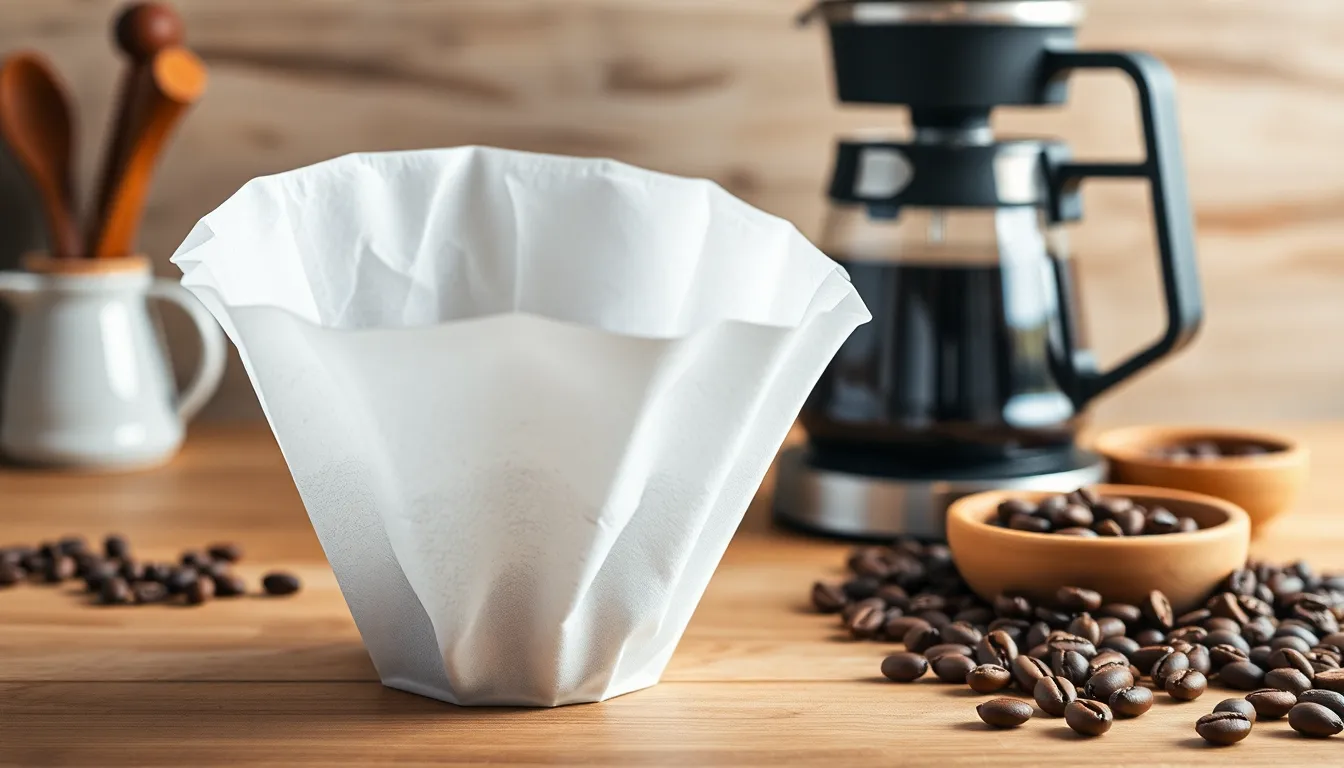
Bleached coffee filters stand out with their pristine white appearance, resulting from chemical processing that removes natural brown coloration. These filters undergo exact manufacturing processes that affect their performance, taste profile, and environmental impact in different ways compared to their unbleached counterparts.
How Bleached Filters Are Made
Bleached filters begin as wood pulp that undergoes additional processing beyond what’s required for standard unbleached filters. Manufacturers spread the pulp into sheets, compress and dry it, then subject it to either chlorine or oxygen bleaching agents to remove lignin—the natural compound responsible for paper’s brownish hue. The oxygen bleaching method represents a gentler alternative that produces fewer harmful byproducts than chlorine bleaching. After whitening, the paper gets cut, shaped, and embossed into the coffee filters you find on store shelves. This additional processing step eliminates impurities while creating the uniform white appearance coffee enthusiasts recognize.
Taste Profile of Bleached Filters
Bleached filters typically deliver a cleaner, more neutral flavor profile in your brewed coffee. The bleaching process removes lignin and other natural compounds that might otherwise impart subtle paper-like flavors into your cup. Many coffee aficionados, including our expert Rikki Manny, note that bleached filters can produce a more transparent taste experience where delicate flavor notes shine through without interference. The absence of paper taste particularly benefits light roasts and specialty coffees with nuanced flavor characteristics. Cupping tests comparing identical coffee brewed through different filter types consistently show that bleached filters introduce fewer extraneous flavors to the final brew.
Environmental Impact of Bleaching
The environmental footprint of bleached filters varies significantly depending on the bleaching method used. Chlorine bleaching creates potentially harmful dioxins and other toxic byproducts that can affect ecosystems if not properly contained. These chemicals pose risks to factory workers and can contaminate water supplies near manufacturing facilities. Oxygen-bleached filters (often labeled as “oxygen” or “elemental chlorine-free”) offer a more environmentally responsible alternative but come with slightly higher production costs. The additional processing also increases energy consumption during manufacturing compared to unbleached alternatives. Environmental considerations lead many coffee shops and home brewers to weigh their priorities between pristine appearance and ecological impact when selecting filters for daily use.
Unbleached Coffee Filters: The Natural Choice
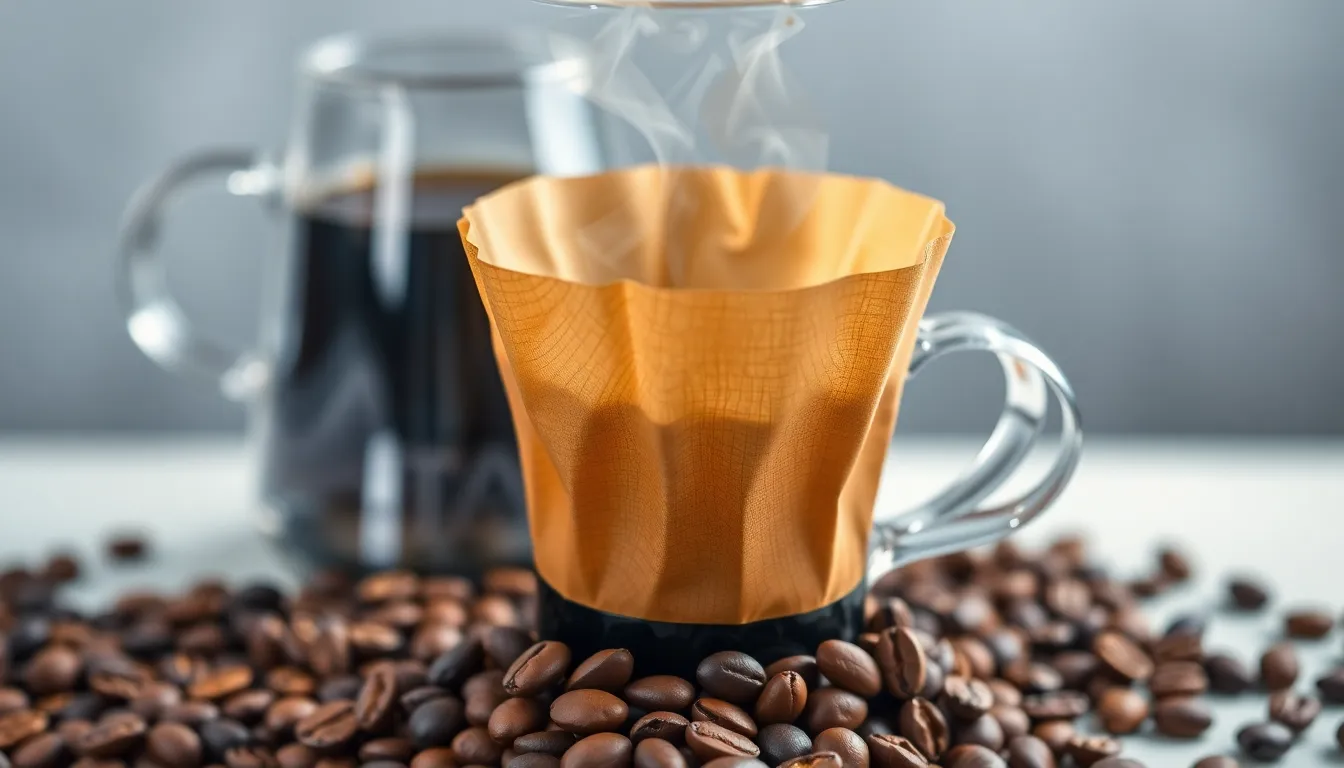
Unbleached coffee filters retain their natural brown color and distinctive appearance by skipping the chemical whitening process. These filters represent a more natural approach to coffee brewing, appealing to environmentally conscious coffee enthusiasts and those seeking a purer brewing experience.
Manufacturing Process for Unbleached Filters
Unbleached coffee filters begin their journey as raw wood pulp that transforms into a paper material with exceptional filtration properties. Manufacturers break down the wood into pulp containing approximately 80% water content, then press and texture this material to enhance its filtering capabilities. Unlike their bleached counterparts, unbleached filters bypass the chemical purification steps involving chlorine or oxygen-based bleaching agents. After the drying phase, the paper undergoes cutting, folding, and embossing to create the familiar conical shape that fits perfectly in your brewing device. This streamlined production process requires fewer chemical interventions and maintains the filter’s natural characteristics.
Flavor Considerations with Unbleached Filters
The absence of bleaching chemicals in unbleached filters can influence the taste profile of your coffee in subtle but noticeable ways. Many coffee drinkers detect a more natural flavor profile due to the lack of chemical residues that might otherwise transfer to your brew. But, because these filters don’t undergo the same purification process as bleached versions, they may impart a slight paper taste to your coffee. Rinsing unbleached filters with hot water before brewing proves effective in minimizing any paper-related aromas or off-flavors that might compromise your coffee experience. This pre-rinse technique takes just a few seconds but can significantly improve the clarity of flavor, especially with lighter roasts where subtle notes are more prominent.
Eco-Friendly Aspects of Unbleached Filters
Unbleached coffee filters stand out as an environmentally responsible choice in your daily brewing routine. Their production consumes fewer resources and generates less pollution compared to bleached alternatives, making them a preferred option for eco-conscious coffee lovers. The manufacturing process avoids chlorine-based chemicals, thereby reducing harmful byproducts such as dioxins that can impact ecosystems. Energy consumption remains lower throughout production since fewer processing steps are required to create the finished product. These environmental benefits come without sacrificing functionality, as unbleached filters perform their filtration duties just as effectively as their bleached counterparts. By choosing unbleached filters, you’re making a small but meaningful contribution to reducing chemical waste and supporting more sustainable manufacturing practices in the coffee industry.
Health Considerations: Dioxins and Chemical Residue
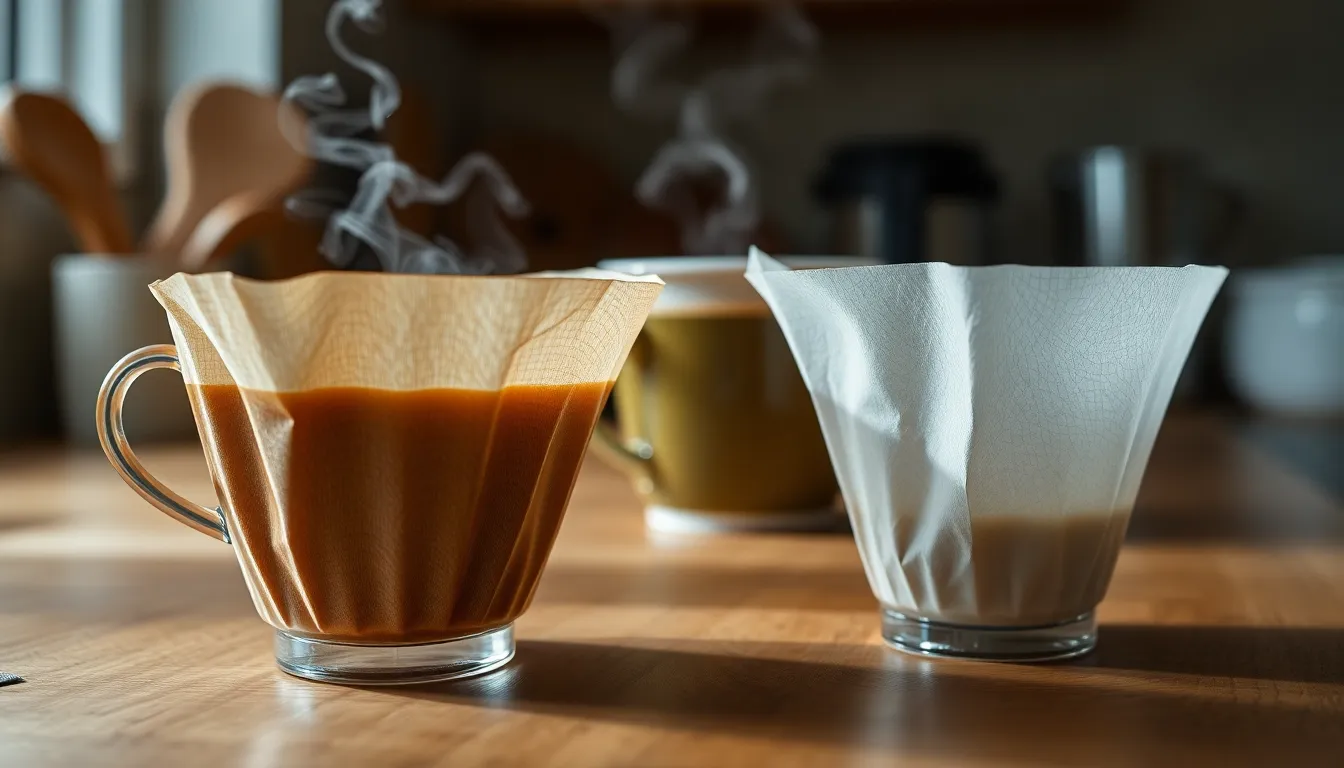
The safety of bleached coffee filters became a concern in the 1980s when studies suggested chlorine-bleached filters might release dioxins—toxic environmental pollutants—into brewed coffee. Modern manufacturing has largely addressed these concerns through improved bleaching methods. Today’s bleached filters typically use oxygen-bleaching or Totally Chlorine-Free (TCF) processes that minimize or eliminate harmful chlorinated residues.
Chemical processing differs significantly between filter types. Bleached filters undergo whitening through either chlorine or oxygen-based methods, while unbleached filters remain in their natural brown state with minimal chemical intervention. This distinction matters for those sensitive to chemical exposure or concerned about potential residues in their daily coffee.
Dioxin risks have diminished substantially with contemporary production standards. Manufacturers have largely replaced elemental chlorine bleaching with TCF or chlorine dioxide methods that don’t form dioxins. Scientific consensus confirms that modern bleached filters pose minimal health risks when used for brewing coffee.
Unbleached filters offer peace of mind for chemically-sensitive individuals. These natural filters bypass bleaching chemicals entirely, eliminating any potential for chlorine-derived compounds to contact your coffee. Many coffee enthusiasts with chemical sensitivities gravitate toward unbleached options for this reason.
Taste implications exist between the two varieties. Bleached filters generally produce a cleaner-tasting cup without papery notes, while unbleached filters might impart subtle paper flavors if not rinsed before use. This taste difference stems from the chemical composition of the filter material rather than any harmful residue.
Environmental considerations often influence consumer choices alongside health concerns. Unbleached filters create less chemical waste during production and decompose more naturally. TCF-labeled bleached filters represent a middle ground, offering the aesthetic benefits of white filters with reduced environmental impact compared to chlorine-bleached alternatives.
Cost Comparison: Is There a Price Difference?
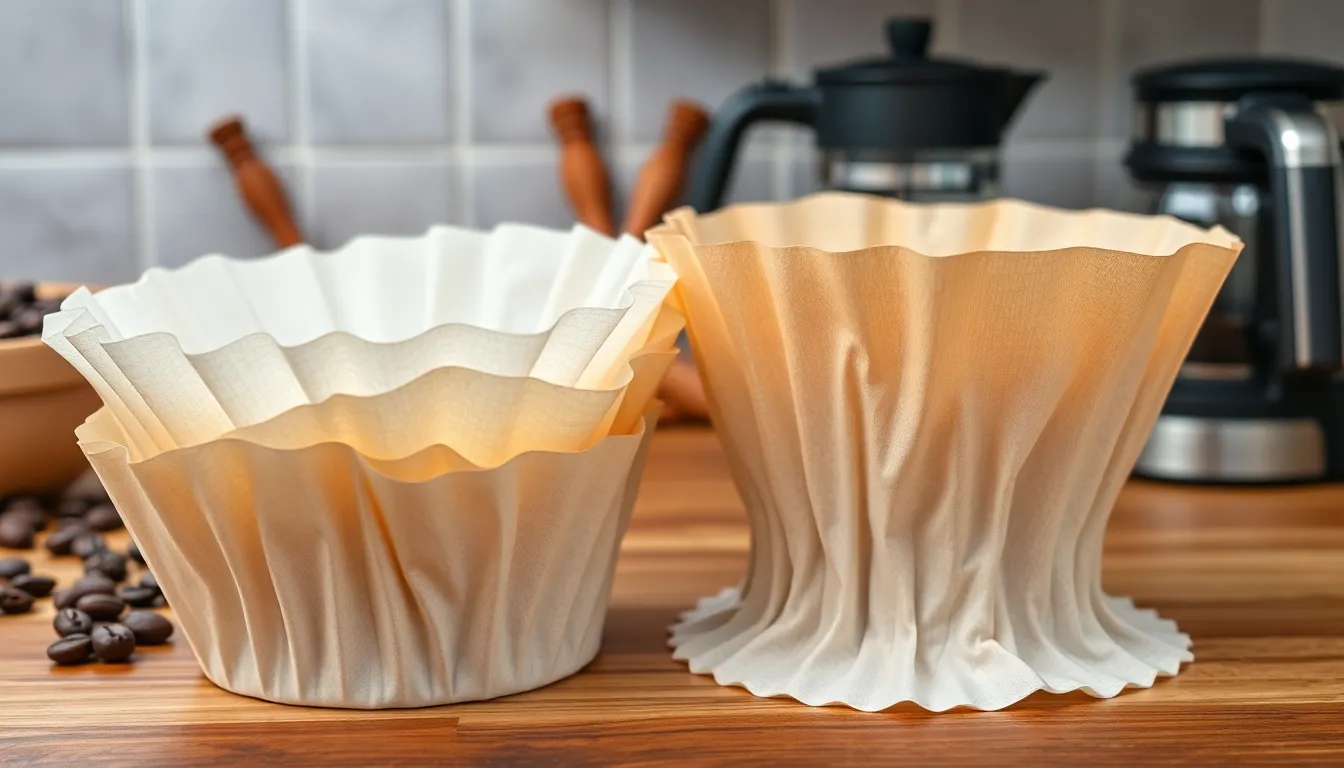
Unbleached coffee filters typically cost less than their bleached counterparts due to their simpler manufacturing process. The absence of chemical bleaching steps reduces production expenses, creating a price advantage for these natural brown filters. Manufacturers pass these savings to consumers, making unbleached options more economical for budget-conscious coffee enthusiasts.
The price gap between filter types remains relatively modest in most retail environments. High-quality unbleached filters occasionally cost similar to or slightly more than basic bleached versions, depending on the brand and filter quality. This price equivalence occurs when premium materials or superior construction offset the savings from skipping bleaching processes.
Oxygen-bleached filters represent a middle ground in the price spectrum. These environmentally friendlier alternatives to chlorine-bleached filters cost more to produce, reflecting their reduced ecological impact. Manufacturers using oxygen bleaching face higher initial production costs but deliver a product that balances environmental concerns with the clean aesthetic many coffee drinkers prefer.
For daily coffee drinkers, the cumulative cost difference becomes more noticeable over time. Using unbleached filters can generate small but consistent savings throughout the year, particularly for households or cafés that prepare multiple pots daily. These incremental savings add up while simultaneously reducing environmental impact.
Price considerations eventually form just one factor in the filter selection process. Many coffee enthusiasts prioritize taste experience and environmental impact over small price differences, viewing their filter choice as an investment in better-tasting coffee or alignment with personal ecological values rather than simply a consumable product.
Which Filter Type Produces the Best Cup of Coffee?
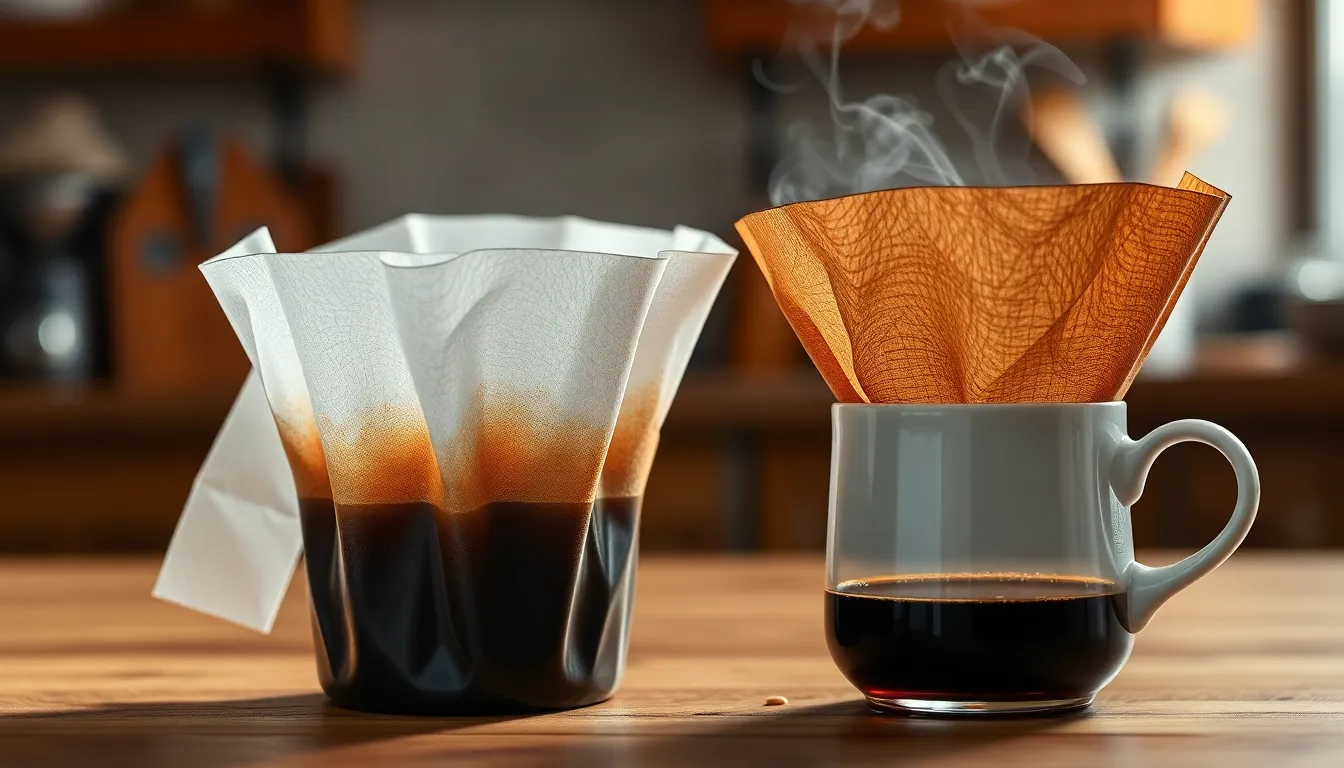
The taste profile of your coffee is significantly influenced by your choice between bleached and unbleached filters. Bleached filters undergo chemical whitening processes using either chlorine or oxygen to remove lignin and impurities in the paper that can affect flavor. These filters generally deliver a cleaner taste when properly rinsed before brewing, allowing the subtle notes in specialty coffees to shine through without interference.
Unbleached filters, with their natural brown color and minimal processing, may introduce slight papery notes into your brew if not rinsed beforehand. Many coffee enthusiasts find that a quick pre-rinse with hot water eliminates this issue completely, resulting in a more natural flavor profile free from chemical residues.
Taste preferences eventually drive the decision between filter types. If you prioritize flavor purity with minimal preparation, bleached filters typically offer a more neutral backdrop for your coffee’s natural characteristics. Coffee experts often recommend bleached filters for light roasts where delicate flavor notes need to come through clearly.
Environmental considerations frequently influence the choice as well. Oxygen-bleached filters (labeled as Totally Chlorine-Free or TCF) represent a middle ground, offering the clean taste benefits of bleached filters with reduced environmental impact compared to chlorine-bleached alternatives. Unbleached filters skip all chemical bleaching processes, giving them the smallest environmental footprint among paper filter options.
The cost difference between filter types is relatively minor but can add up for daily coffee drinkers. Unbleached filters typically cost less due to their simpler manufacturing process, making them both an economical and environmentally conscious choice for regular coffee brewing.
Both filter types can produce exceptional coffee when used correctly. Your decision should align with your personal priorities about taste, environmental impact, and budget. The subtle differences in flavor between properly rinsed bleached and unbleached filters might not be noticeable to casual coffee drinkers, but coffee connoisseurs often develop strong preferences based on how each filter type complements their favorite beans and brewing methods.
How to Choose the Right Filter for Your Brewing Method
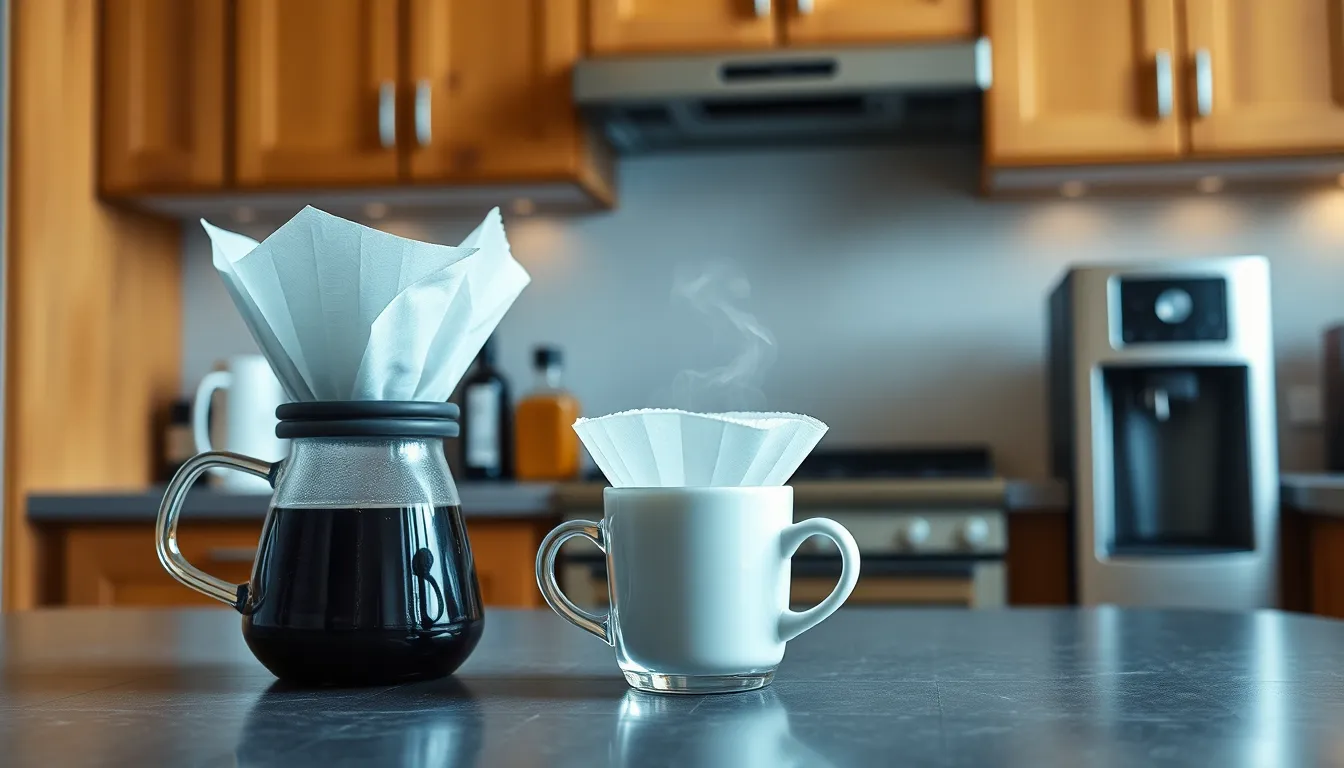
Selecting the perfect coffee filter requires matching your filter type to your exact brewing equipment. Different coffee makers use distinct filter shapes and sizes designed to optimize extraction based on their unique brewing mechanisms.
Flat-Bottom Filters
Flat-bottom filters excel in traditional drip coffee makers like Mr. Coffee and Moccamaster. These wider filters provide a large surface area that promotes even water distribution throughout the coffee grounds. For these brewers, both bleached and unbleached options work effectively, with the choice primarily coming down to your taste preferences and environmental concerns. The flat design creates a more uniform extraction bed, resulting in balanced flavor development during the brewing process.
Cone-Shaped Filters
Cone filters perform best in pour-over systems such as Kalita Wave, Chemex, and Melitta brewers. Their tapered design funnels water through a deeper coffee bed, creating a slower flow rate that enhances extraction. The choice between bleached and unbleached cone filters subtly affects your final cup—bleached filters typically deliver a cleaner taste that lets delicate flavor notes shine through, while unbleached filters may add slight earthy undertones unless pre-rinsed.
Specialty Brewing Methods
AeroPress and similar immersion brewers use disc-shaped paper filters that trap oils and fine particles for a remarkably clean cup. Metal mesh filters, available for French Press and some pour-over systems, allow more oils to pass through, creating a fuller-bodied coffee with richer mouthfeel. Your preference for clarity versus body plays a crucial role in determining which filter material suits your brewing style.
Matching Filters to Coffee Types
Light roasts benefit from bleached filters’ neutral profile, which preserves their bright, complex flavors. Medium to dark roasts pair well with unbleached filters, as their bolder flavors aren’t significantly affected by slight paper notes. For specialty single-origin coffees with distinct tasting notes, oxygen-bleached filters offer an excellent middle ground—minimal environmental impact with clean flavor transmission.
Pre-Rinsing Technique
Pre-rinsing filters eliminates potential paper taste, particularly important with unbleached varieties. Simply place your filter in the brewer, pour hot water through until the filter is fully saturated, then discard the rinse water before adding coffee grounds. This quick step takes only 15-30 seconds but significantly improves your coffee’s clarity regardless of filter type.
Conclusion
The choice between bleached and unbleached coffee filters eventually comes down to your personal priorities. If you value pristine aesthetics and a clean taste profile that showcases delicate flavors you’ll likely prefer bleached filters especially oxygen-bleached ones that minimize environmental impact.
For those prioritizing sustainability natural processing and cost-effectiveness unbleached filters offer compelling advantages even though the potential need for pre-rinsing. The slight price difference becomes more important for daily brewers over time.
Remember that matching your filter to both your brewing method and coffee roast level can dramatically improve your results. Whether you choose bleached or unbleached the most important factor is consistency in your brewing routine to achieve that perfect cup every morning.
Frequently Asked Questions
What is the main difference between bleached and unbleached coffee filters?
Bleached filters are white due to chemical processing that removes natural brown coloration, while unbleached filters retain their natural brown color by skipping the whitening process. Bleached filters typically produce a cleaner, more neutral flavor, while unbleached filters may impart subtle paper notes but are more environmentally friendly with fewer chemical residues.
Do bleached coffee filters affect the taste of my coffee?
Yes, bleached filters generally produce a cleaner cup with more neutral flavors, allowing delicate notes in light roasts and specialty coffees to shine through without interference. Modern bleached filters contain minimal chemical residues, but some coffee enthusiasts still prefer unbleached filters for a more natural brewing experience.
Are bleached coffee filters safe to use?
Modern bleached coffee filters are considered safe for use. Manufacturers have improved their processes with oxygen-bleaching and Totally Chlorine-Free (TCF) methods that minimize harmful residues like dioxins. However, unbleached filters provide additional peace of mind for those particularly sensitive to chemicals.
Why would someone choose unbleached coffee filters?
People choose unbleached filters for environmental reasons (less chemical waste, more natural decomposition), potential health benefits (no bleaching agents), cost savings (typically less expensive), and taste preferences (some prefer the more natural flavor profile, especially with medium to dark roasts).
Should I rinse my coffee filters before brewing?
Yes, especially for unbleached filters. Pre-rinsing with hot water helps eliminate the potential paper taste that can affect your coffee’s flavor. This quick step enhances the overall clarity of your brew and is considered a best practice by many coffee professionals regardless of filter type.
Which filter is better for different brewing methods?
For drip coffee makers, flat-bottom filters (bleached or unbleached) work well. Pour-over systems benefit from cone-shaped filters, with bleached filters highlighting delicate flavors in light roasts. For AeroPress, paper filters produce cleaner cups while metal filters allow more oils through. Match your filter to both your brewing method and coffee type.
Are unbleached coffee filters more environmentally friendly?
Yes, unbleached filters have a lower environmental impact. Their production requires fewer chemicals, consumes less water and energy, and generates less pollution. They also decompose more naturally after use. For the most eco-conscious choice, look for unbleached filters made from sustainably sourced paper.
Is there a significant cost difference between filter types?
The cost difference is modest but can add up for daily coffee drinkers. Unbleached filters typically cost less due to simpler manufacturing. Oxygen-bleached filters are usually the most expensive option. While the per-filter price difference may be small, regular coffee drinkers might save $10-20 annually by choosing unbleached filters.
Can I compost coffee filters?
Yes, both bleached and unbleached paper coffee filters can be composted, but unbleached filters are preferable for composting. They break down more naturally without introducing bleaching chemicals into your compost. Always check that filters are free from synthetic materials before composting, and include the used coffee grounds for added compost benefits.
Which filter should I use for specialty coffee?
For light roasts and specialty coffees with subtle flavor notes, bleached filters (preferably oxygen-bleached) are often recommended as they provide a cleaner cup that highlights delicate flavors. For medium to dark roasts with bolder profiles, unbleached filters work well, especially when pre-rinsed to remove any paper taste.

